SWE’s 2019 IGED Introduces Illinois Girls to Engineering
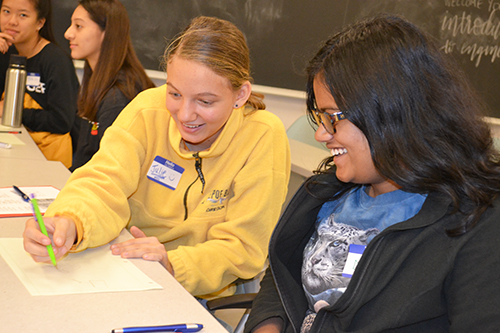 Two high schoolers enjoy an activity during IGED.
Two high schoolers enjoy an activity during IGED. November 15, 2019
At SWE’s 2019 Introduce-a Girl-to-Engineering Day (IGED) on October 26th, Illinois engineering students who participated in the all-day event did just what its name implies. They acquainted around 110 high school girls (the most to ever participate in the event), with what different engineering disciplines are like, what careers are available in the different fields, and what studying engineering at Illinois might be like. Sponsored by SWE Illinois (the Society for Women Engineers) on campus, the event did more than just introduce the girls to the different engineering disciplines; it also gave them a chance to interact with Illinois engineering students. Meanwhile, their parents (around 100 or so) hung around to find out about the admissions process, talk to current upperclassmen, and get a feel for what studying at Illinois might be like for their daughters.
While IGED was hosted by SWE, members of other engineering RSOs (Registered Student Organizations) were also invited to participate. In addition to involving a multi-disciplinary cross-section of students from the campus engineering community, IGED also allowed the high school girls to learn more about these RSOs should they matriculate to Illinois.
 High school students make a prosthetic hand during the bioengineering session at Introduce-A-Girl-to-Engineering Day.
High school students make a prosthetic hand during the bioengineering session at Introduce-A-Girl-to-Engineering Day. The morning featured girls rotating through different activities where they learned about some different engineering majors, including computer science, and bioengineering. Leading the morning activities were campus chapters of Girls Who Code, an RSO that encourages middle and high school girls to learn about computer programming; AOE (Alpha Omega Epsilon), an engineering sorority; and BMES (the Biomedical Engineering Society).
Also, over pizza at lunch, girls who were wondering “What is college like?” and “How's college different from high school?” were able to ask those questions of a panel of current Illinois students.
Following lunch, IGED featured an RSO segment, where different members from RSOs came and talked about what they do. For example, EWB (Engineers Without Borders) shared about their efforts to solve engineering problems in other countries. Another participating RSO was Concrete Canoe. (Yes, just as the name implies, they build canoes out of concrete; the challenge, of course, is to get them to float!) Also presenting was the Illini Motor Sports’ Baja car team, whose members shared about their passion for cars. SWE also presented during the RSO segment.
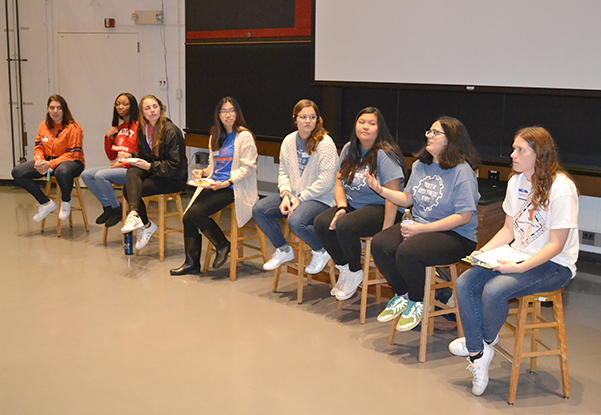 A panel of Illinois Engineering students answer high school students' questions during lunch.
A panel of Illinois Engineering students answer high school students' questions during lunch.In the early afternoon, the girls participated in a design challenge related to this year’s theme: Monopoly. As everyone knows, the goal of Monopoly is to put a bunch of red hotels on all of one’s properties. IGED’s design challenge ameliorated that objective by relating it to engineering. For instance, teams of girls designed earthquake-resistant hotels, which, when finished, were tested by being shaken vigorously. Teams with the sturdiest hotels received prizes.
At the end of the day was a majors fair comprised of students from the 14 different disciplines in the Grainger College of Engineering, providing another opportunity for girls to learn more about how the engineering majors differ from one another. At the fair, the high schoolers loaded up on propaganda while chatting with current students in those majors. Also, girls who wanted to know “What do you do in your major?” “What classes do you take?” and “What kinds of careers are related to this major?” got their questions answered.
Why are events like IGED important? According to Saloni Nargarkar, one of SWE’s two 2019–2020 outreach coordinators, the outreach goal for this year is “Inspiring the Next Generation,” and their IGED goal was to do just that.
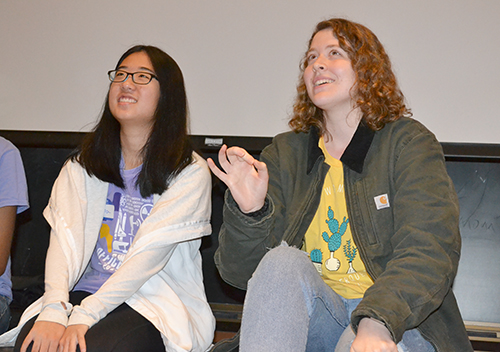 Two Illinois Engineering students share about their experiences at Illinois as part of a student panel scheduled for parents during IGED.
Two Illinois Engineering students share about their experiences at Illinois as part of a student panel scheduled for parents during IGED.“So at this event, we're not trying to tell them, ‘Oh, you should go into engineering. You have to do engineering!’ We're trying to ignite that spark in them that gets them curious about engineering so that when they go back home they're like, ‘Oh, that was really interesting, that thing that I learned today!’ and they want to learn more about it.”
Nargarkar, who has helped out with IGED for the last three years, shares one reason why she keeps volunteering for the event. She’s currently studying engineering because as a girl, she participated in engineering outreach activities similar to IGED at another university. “I want to make sure that other girls have the same opportunities,” she says.
She shares another way IGED helps. As high school students, a lot of times, it's hard to see the application of those things that you do in class. “So coming to events like this, we show them exactly what they would be doing in the future. We show them exactly what they can get involved with. So it's a good way to make sure that they know that they can pursue this as a field.”
 An Illinois Engineering student (left) interacts with a high schooler during one of the IGED activities.
An Illinois Engineering student (left) interacts with a high schooler during one of the IGED activities.And finally, she admits, “It just brings me joy and happiness to know that I'm inspiring the next generation of female engineers, because they are the future.”
Like Nargarkar, her fellow SWE outreach co-coordinator, Kylie Burkett, has also been involved with SWE outreach her four years on campus. The senior in Civil and Environmental Engineering, with a focus on environmental, also served as the chair of IGED last year.
Burkett shares why she personally got involved with SWE outreach. “So I didn't have these sorts of resources when I was in high school. I never went to STEM camp or Introduce-a-Girl-to-Engineering Day. So for me, it's more so just making sure they know that this opportunity is there.” However, while Burkett didn’t attend STEM events, she admits that she was fortunate in that she had very supportive parents who pushed her and encouraged her to go into engineering. “But not everyone has that, right?” She adds, “Cause not all parents know about it either.” That’s one reason IGED also involves the parents, to show them how they can be supportive to their daughters.
The fall 2019 IGED had the most girls ever to participate in the event. So how did SWE manage to attract this record-breaking number of girls? “I think it's really just about contacting teachers and just getting the word out and making it exciting,” Burkett explains. One thing that helped was that SWE was fortunate to get funding from Women in Engineering (WIE), which paid for registration costs. Thus, they were able to make the event free. They also reached out to the girls who had participated in IGED last year. In addition, they did a good job of contacting teachers in the Chicago suburbs.
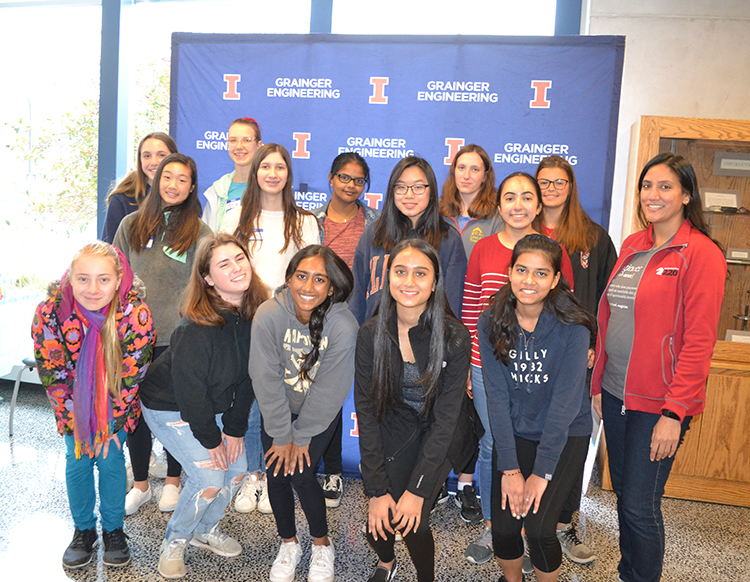 Barrington High School Engineering teacher Karuna Parmar (right), and the group of students she brought to IGED.
Barrington High School Engineering teacher Karuna Parmar (right), and the group of students she brought to IGED. For instance, one teacher who heard about IGED and agreed that it was worth heading south for the day was Karuna Parmar, who teaches engineering at Barrington High, in Barrington, Illinois, a suburb northwest of Chicago. Parmar brought a bus full of 15 girls to IGED, along with some teachers, parents, and even a female bus driver. Parmar says some of the girls were from her own engineering classes. “I invited them,” she explains.
However, some of the group were also encouraged to come by another teacher at the school who works with underrepresented students. Explaining that, “Females are in the minority in engineering and in STEM fields, really,” Parmar says her colleague administered a survey to find out how many underrepresented students had an interest in engineering.
“And we opened up this event to them and said, ‘Hey, we'll take you down there if you don't have the means to get there, with your parents being busy, etc.’” As a result of the survey, she explains, “We were able to narrow down the specific students that we wanted to bring to this. And this being an all-female event, we were like, ‘All right, girls are a minority. We're bringing our girls down here.”
While they brought a senior and a couple of sophomores, most of the girls who participated in IGED were freshmen. Parmar agrees that exposing freshmen to an event like IGED could be really impactful. For instance, if the girls were to find engineering intriguing, then throughout the rest of their high school careers, they could take courses that prepare them, or participate in clubs and other activities that help them learn more about engineering.
“Exactly,” Parmar agrees. “Get them while they're young.” In fact, at Barrington, they’re getting them even younger—at the middle school. Plus, she says that in recent years, Barrington District has developed a STEM program at the elementary school too. “So we're getting them way younger,” she adds.
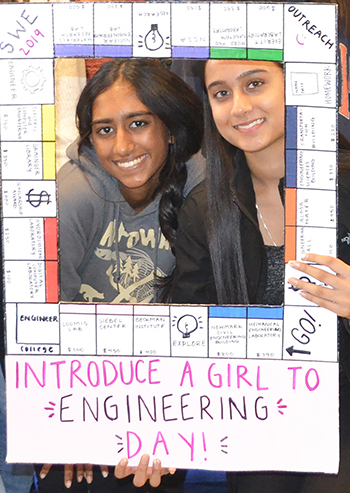 Two Barrington High students enjoy their time at IGED.
Two Barrington High students enjoy their time at IGED.
Parmar shares why she’s encouraging girls in engineering. When she started teaching engineering in 2009, she had two female students, and said to herself, “This is not right. We need to have a pretty good balance at this.”
In fact, she acknowledges that female students definitely have what it takes to be great engineers. “To be honest, these female students that I have are my best students. They're very organized; they're very detailed oriented; and they're focused.”
So Parmar realized that she wanted more students like that. But she wasn’t the only one who wanted to see more girls going into engineering—some companies did too.
“I've had conversations with professionals and companies and recruiters that say, ‘We're looking for more females because of those key characteristics.’ Regarding female students’ strengths, she adds, “They're not just there to make PowerPoints. They can do beyond that. They're great with their hands-on, and they're able to think much more outside of the box than some of the guys can, honestly. And I've seen that they tend to be the leaders in the group because they want the project done and done well.”
Elaborating on the differences between boys and girls, Parmar adds, “Some of our boys are just like, ‘All right, let's get this done, and then we have free time.’ They rush through some of that and they're not very good at documenting the design process as well.” However, she says her female students’ work outlines everything that they've done.
“Anyone not in a technical field would be able to understand what they've done to solve that problem. It's not the same with the guys. The guys could learn from these girls.”
However, while Parmar tries to ensure that each project team has a girl, she doesn’t have enough females. So while the ratio of guys to girls has improved slightly over the last 10 years, (it's grown from two in 2009 to seven in her largest class of 26), here’s hoping that some of the girls she brought to IGED will choose engineering and change the ratio of women in the futue, not just in her engineering classes, but in the field.
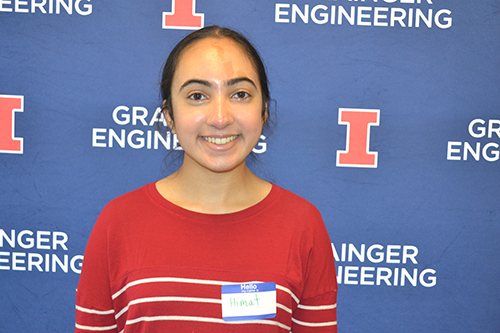 Himat Sidhu, a Barrington High freshman who's particularly interested in bioengineering.
Himat Sidhu, a Barrington High freshman who's particularly interested in bioengineering.Himat Sidhu, one of Parmar’s freshmen who appreciated her time at IGED, shares why she participated and some things she found particularly beneficial.
“Well, I'm interested in all the STEM fields, basically,” Sidhu explains, adding that, “I want to become maybe a doctor or maybe go into bioengineering. I want to major in one of these things. So I thought it would be good to start early and get a feel for whatever things I like.”
Given her interest in bioengineering, her favorite activity of the day, of course, was the bioengineering segment during which she made a prosthetic hand.
“Yeah, that was pretty fun. I got to talk to one of the college girls there, and she told me a lot about how she decided to go into that field and what she likes about it. So it's been really informative. I've gotten to talk to a lot of people.”
As a freshman with quite a few years of high school left, what impact did Sidhu believe participating in IGED might have on the rest of her high school career?
“Well, I think that when I get an idea of like what I like and what I don't like about the engineering and STEM fields from today, then I can kind of apply that to what classes I want to take for the rest of high school, what clubs I want to do, maybe where I want to volunteer, and that can help me decide what I want to major in. I think it'll help a lot.”
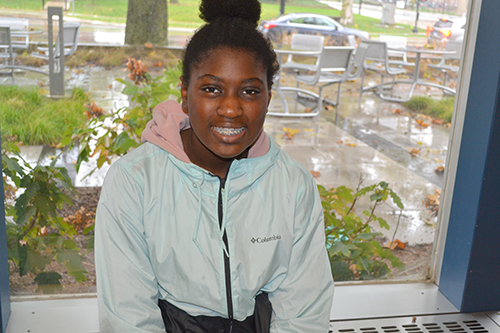 Uni High sub-feshman Xenial Mingwa.
Uni High sub-feshman Xenial Mingwa. Another participant who got an even earlier head start in figuring out what she wants to do down the road was Xenial Mingwa, a sub freshman (eighth grader) who attends Uni High in Urbana. She shares why she participated in IGED. “I came because I'm interested in engineering, and I want specifically aerospace, but I also want to learn about the different fields of engineering and what other options there are.” Mingwa’s favorite thing so far was getting to learn about different engineering fields and knowing her options.
Regarding what impact coming to IGED might have on her high school career, she believes it will help her decide, “what I want to do in the future and how I'm going to get there.” She adds that it will probably impact what courses she ends up taking, “Probably courses. Courses, definitely.”
Upon being reminded that if she does end up choosing engineering, Illinois is a really good engineering school,” Mingwa acknowledges, “Yeah. We're considering coming here.”
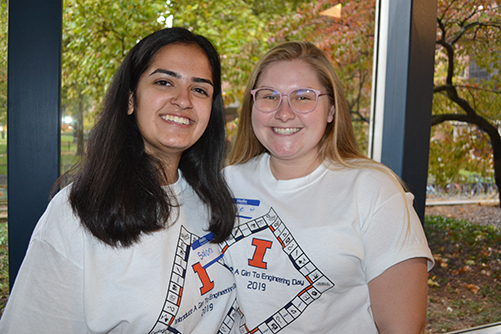 Saloni Nargarkar and Kylie Burkett, the 2019-2020 SWE outreach co-coordinators.
Saloni Nargarkar and Kylie Burkett, the 2019-2020 SWE outreach co-coordinators.In addition to the positive impacts participants reported gaining from IGED, Burkett mentions another major impact she believes the day had on participants—showing them the diversity of women in engineering. “I think it really just shows them that there's a lot of different people, different women in engineering, right. And not all of us have the same background. Not all of us took AP courses. Not all of us got all these scholarships. Not all of us got a 36 on our ACT. Right? So really showing them the diversity, showing them that it's fun. I just think their exposure to people that are in this situation really gives them an insight into it.”
Both ladies believe one key way IGED inspires the girls is by conveying, “If I can do it, you can do it!” For instance, Burkett says successful outreach is about just creating the opportunity and inspiring girls by serving as role models, saying, “Look at me. I'm here. You can do this too!”
Nargarkar agrees that by coming to IGED, the participants had a chance to meet women who are currently studying engineering and become inspired that they too can become engineers. “They can see, ‘Oh, they're doing it. I can also do it. It's something that's very doable in my future!’”
 A Barrington High student currently in Parmar's intro to engineering class (right), and another high schooler enjoy an activity during IGED.
A Barrington High student currently in Parmar's intro to engineering class (right), and another high schooler enjoy an activity during IGED. Story and photos by Betsy Innes, Communications Specialist, I-STEM Education Initiative.
More: 8-12 Outreach, Engineering, SWE, Women in STEM, 2019
For additional I-STEM web articles about Introduce-a Girl-to-Engineering Day, see:
- SWE’s Introduce-a-Girl-to-Engineering Day Encourages High School Girls to Embrace Stranger Things—Such as a Career in Engineering
- At Introduce-a-Girl-to-Engineering Day, High School Girls Learn About Engineering—and That They Can Do It
- Girls Discover that Engineering Is Sweet at Introduce-A-Girl-to-Engineering Day
- Introduce-a-Girl-to-Engineering Day Tells Girls: "You Can Be an Engineer, Change the World!”
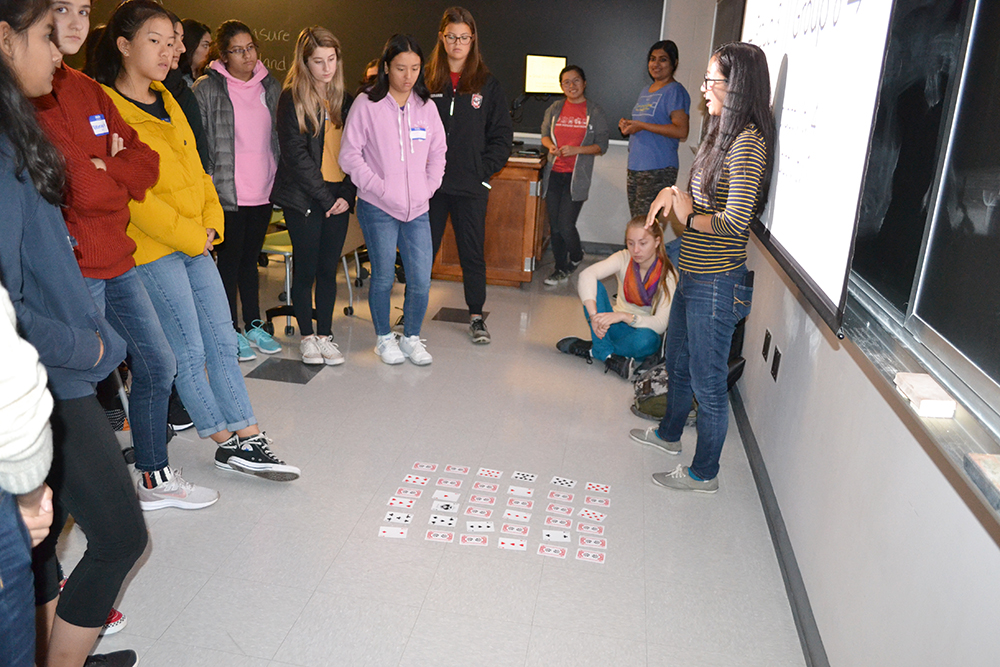 A member of Girls Who Code uses a card trick to teach a principle about coding.
A member of Girls Who Code uses a card trick to teach a principle about coding. 












.jpg)
















